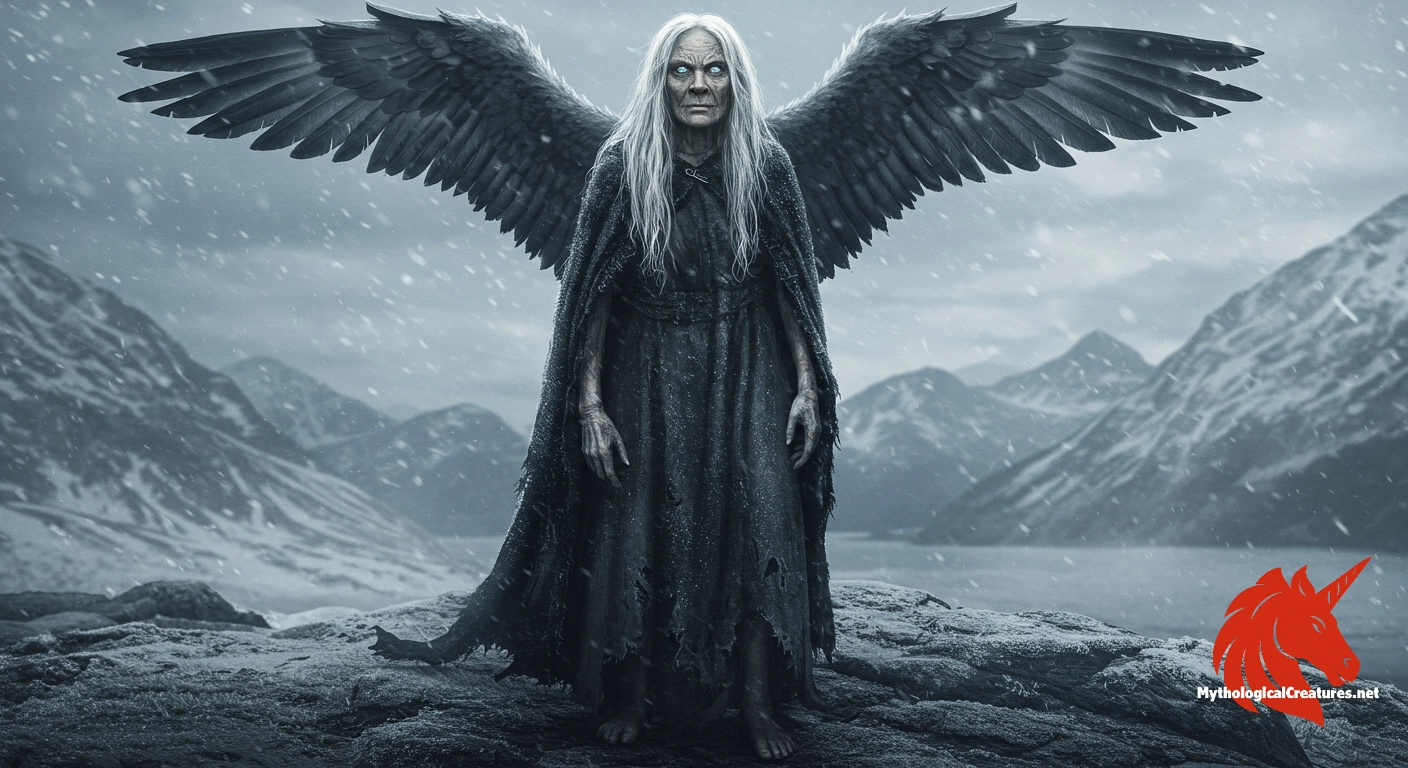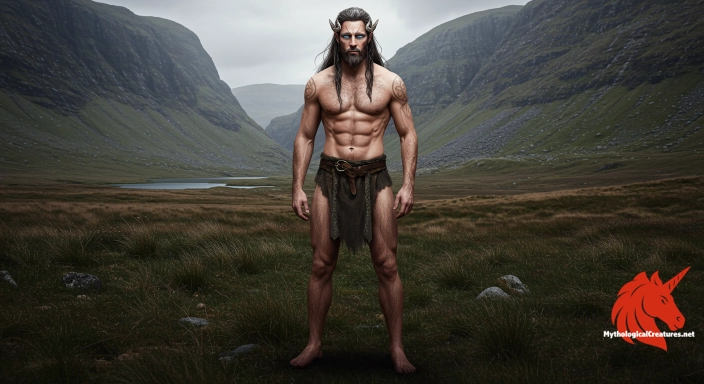Cailleach: The Cailleach is a divine hag from Gaelic mythology, revered and feared for her command over winter and the natural landscape.

Cailleach
Cailleach - A central figure in Gaelic mythology, symbolising the harsh yet regenerative force of winter.
Origins & First Encounters
The Cailleach is a formidable and enigmatic figure in Gaelic mythology, embodying both the primeval aspects of nature and the inexorable passage of time. Her presence in Gaelic lore is steeped in the mystique of ancient winter rituals and the transformation of the landscape, making her a symbol of nature’s raw power. Born of a time when myth intertwined with everyday life, she is portrayed not only as a creator but also as a custodian of the harsh winter season. In early folklore, her character emerges as one of wisdom borne of hardship, carrying the weight of both creation and inevitable decay. Her divine role is underscored by her ability to sculpt the mountains and valleys, thereby setting the stage for the cyclical drama of the seasons. She was first attested in the oral traditions and later in literary texts used by Gaelic communities to understand the forces of nature. Across Ireland, Scotland, and the Isle of Man, her legend has been handed down through generations, each culture imbuing her with traits that resonate with their unique environmental narratives. Through the lens of myth, the Cailleach has come to represent the eternal struggle between the bountiful warmth of life and the chill of winter, a theme that continues to captivate and inspire. In her story, nature is both revered and feared, mirroring the dual aspects of human experience in a world governed by the unpredictable rhythm of the seasons.
Source Texts & Tale Variants
The treasures of Gaelic folklore provide a multitude of sources where the Cailleach’s persona is preserved and reinterpreted. Several ancient texts, along with a rich tradition of oral storytelling, detail her presence as both a creator and an arbiter of winter. The documentation spans from early manuscripts to lyrical ballads that capture the essence of a deity who controls the very fabric of the natural world. In Irish tradition, she is sometimes celebrated as the Hag of Beara, a moniker that conveys both age and mystical authority, while Scottish accounts revere her under the regal title of Beira. The existence of these diverse variants indicates the fluid nature of myth, where regional differences shape the narrative to suit local cultural contexts. In various manuscripts, she appears as a central figure who explains the seasonal shifts and the origin of the landscape. These texts, although written in scattered locales and times, share a common thread of a deity who bridges the mortal world and supernatural forces. Furthermore, local folklore often complements these ancient writings with stories of her benevolence and wrath, thereby enrichening her mythos. The collective body of sources demonstrates that her legend, though cloaked in mystery, has been an enduring symbol of power and transformation amid the natural and supernatural realms.
Form & Powers
The visual depiction of the Cailleach is as layered and textured as the landscapes she is said to have created. Often illustrated with a stark, weathered visage, her appearance is marked by deep-set eyes that reflect both ancient wisdom and the chill of winter air. Artists have traditionally portrayed her with prominent, gnarled features that speak to the relentless passage of time and the toll of harsh environmental forces. Her long, unkempt hair and wrinkled skin evoke images of rugged, weather-beaten landscapes, whilst her eyes shimmer with a mysterious reflective quality reminiscent of frost under moonlight. Some accounts describe her as cloaked in garments that seem spun from the very fabric of night and winter, adorned with motifs of snowflakes and swirling mists. The duality in her depiction is striking; at times she appears as a nurturing sculptress of nature’s contours, and at other times as a fearsome harbinger of the snowbound season. Variations in her size and stature emphasize different attributes—sometimes majestic and imposing, other times frail yet formidable, reflecting the thematic interplay of creation and decay. Elements of natural materials, such as bark and stone-like textures, are often incorporated into her iconography to symbolise her intimate connection with the earth. Her physical form, both human and elemental, has come to represent an ever-changing tapestry that mirrors the volatile yet cyclical nature of the seasons.
Regional Faces
Across the Gaelic-speaking regions, the legend of the Cailleach undergoes a fascinating transformation shaped by local environmental influences and cultural nuances. In Ireland, her figure is often seamlessly integrated into narratives that emphasise her creative and nurturing powers as much as her formidable presence during the long winter months. Scottish traditions, on the other hand, tend to elevate her status to that of a reigning queen of winter, imbuing her character with a sense of regality and authoritative control over the natural order. Meanwhile, the Isle of Man presents her in a slightly more mystical light, where the intersection of folklore and the supernatural is more pronounced. Regional festivals and folklore events across these areas often adapt her story to reflect local ecological phenomena, such as the relentless highland winds or the serene, snow-clad coastlines. These geographical adaptations reveal not only variations in physical depiction but also in the values and lessons each culture wishes to communicate about nature. In some locales, she is seen as the gentle guardian of the natural world, while in others, her cold, austere aspects dominate, warning of the harsh realities of winter. The variations underscore the adaptability of her myth, which has been moulded over time to resonate with the concerns and experiences of each community. By evolving to suit regional beliefs and conditions, the Cailleach maintains her relevance as both a cultural and environmental icon in the diverse Celtic lands.
Cultural Parallels
The myth of the Cailleach shares intriguing resonances with numerous other deities and legendary figures found in different cultural traditions. In Northern European lore, the spirit of winter and the harsh realities of nature are echoed in figures such as the Norse goddess Skadi, a deity whose dominion over the icy wilderness mirrors the formidable power of the Cailleach. Within Mediterranean mythology, echoes of Demeter’s influence on the seasonal cycles and agricultural fertility can also be compared to the dual nature of the Cailleach as both a nurturer and a stern avenger. Across various cultures, the embodiment of nature’s relentless change is a recurring theme in myth, where personified figures serve as metaphors for the cycles of birth, decay, and renewal. These cross-cultural parallels highlight a shared human impulse to understand and contextualise the forces of nature, be they through goddess figures, spirit guardians, or elemental deities. In each tradition, similar narratives emerge around the idea of a powerful feminine force responsible for the delicate balance between life and the forces that threaten it. Such figures often carry the burden of both creation and destruction, symbolising the perpetual tug-of-war between opposing natural energies. The comparative analysis of these myths not only underscores the universality of seasonal narratives but also amplifies the symbolic depth attributed to the Cailleach in the larger tapestry of world mythology. As cultures looked to nature for meaning, the legend of the Cailleach became one of many vibrant threads in the global narrative of elemental deities.
Legacy & Modern Evolution
The evolution of the Cailleach from a fearsome winter deity to an emblem of enduring natural power reflects both historical change and contemporary reinterpretation. Over centuries, her portrayal has been refined, shifting from violent natural forces to a more complex character who embodies both the beauty and the inevitability of winter. Early representations were deeply tied to agrarian cycles and the mysticism of rural life, with the deity revered for her capacity to shape and transform the landscape. In more modern times, her image has been rediscovered within literary and artistic movements that seek to reclaim ancient symbols as a means of exploring gender, nature, and environmental ethics. This modern reinterpretation often casts her as a feminist icon, representing the strength and resilience inherent in both nature and femininity. Contemporary storytellers and visual artists have embraced her narrative to address issues of ecological sustainability and the human relationship with the natural world. Her enduring relevance is evident in festivals, re-enacted rituals, and a growing body of creative work that bridges myth with modern ecological concerns. Today, the Cailleach stands as a potent symbol of transformation, serving as a reminder that both beauty and harshness exist as natural parts of life’s continuous cycle. The adaptive legacy of her myth continues to inspire and challenge modern audiences, ensuring that her story remains as dynamic as the ever-shifting seasons.
Interesting Fact
An intriguing aspect of the Cailleach is her dual role as creator and harbinger; while she ushers in the harshness of winter, her influence is vital for the cyclical renewal of the land.
Quick Creature Info
Associations:
Our Mythic Legendary Rating:

Also Sometimes Known As:
Habitat:
Supernatural Powers:
Physical Attributes:
Abilities:
Behavior:
Lore:
Related Creatures, Tales or Lore
- BBaba Yaga
- HHecate
- SSkadi
References
Discover Another Mythical Legend You May Not Have Heard Of?
Uncover the mysteries of ancient folklore and expand your knowledge of legendary beings from cultures around the world.
Dare to Meet the Fráech....
Mythical Disclaimer: The images and data on this site are derived from various historical and literary sources, but we have found that many myths often have multiple versions and interpretations across references, sometimes contradictory. As a result, these creature depictions are artistic interpretations—imaginative blends of folklore, legend, and a dash of AI guesswork. Because creature descriptions vary widely, our illustrations and accompanying information represent our best effort to honor mythology while bridging creative gaps. Enjoy these interpretations—just remember, we've done our best to respect the stories and validate available data, but in the realm of mythology, details often shift, imagination leads the way, and nothing is ever set in stone!
Curated by the Mythological Creatures Team (rev. May 2025)
